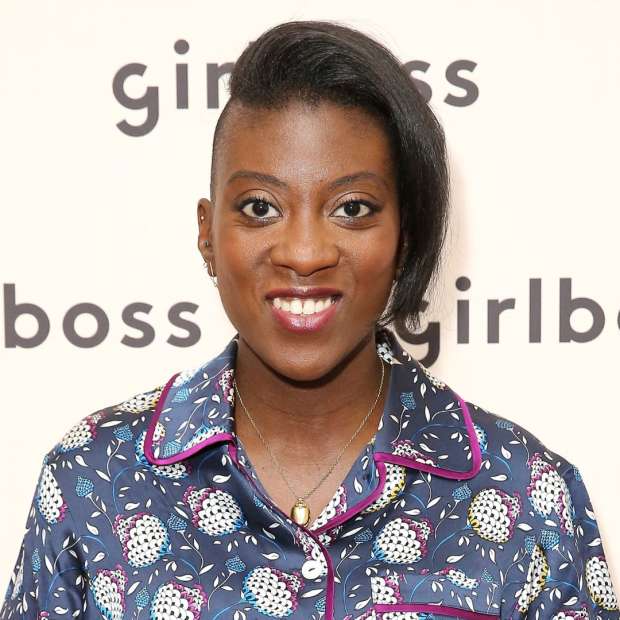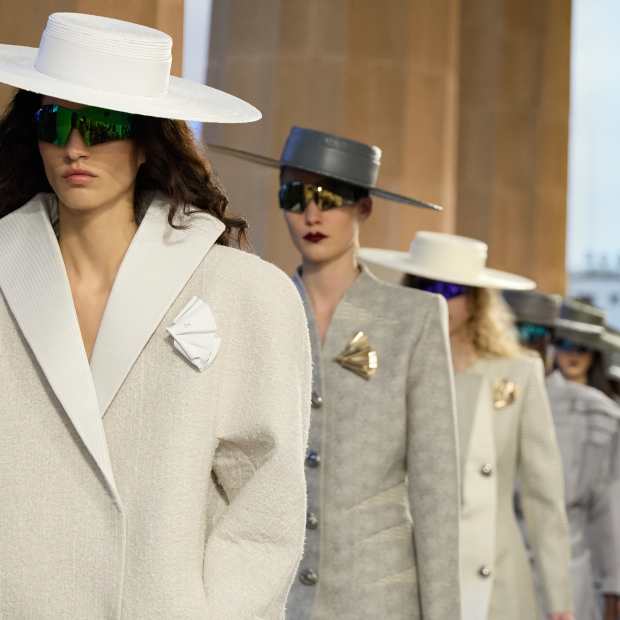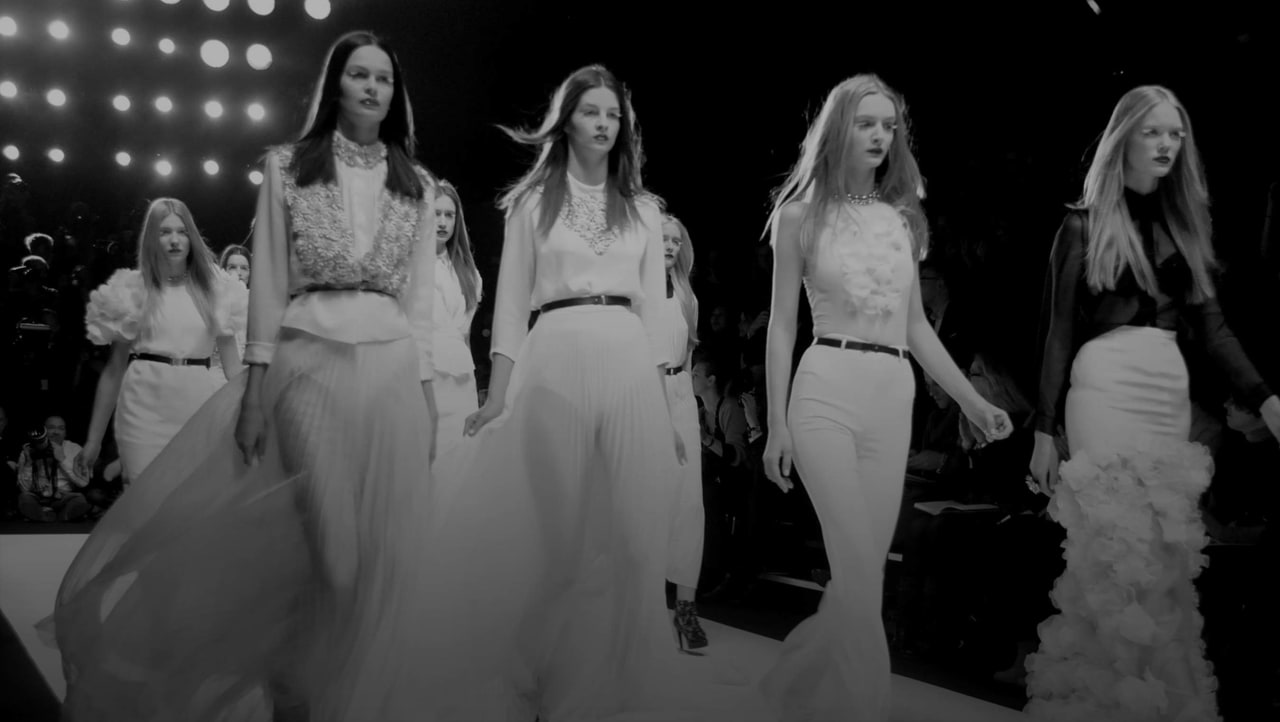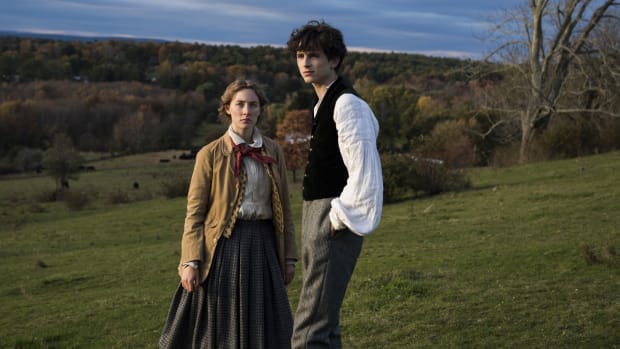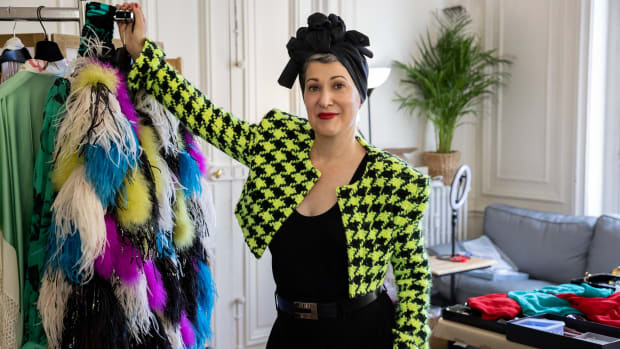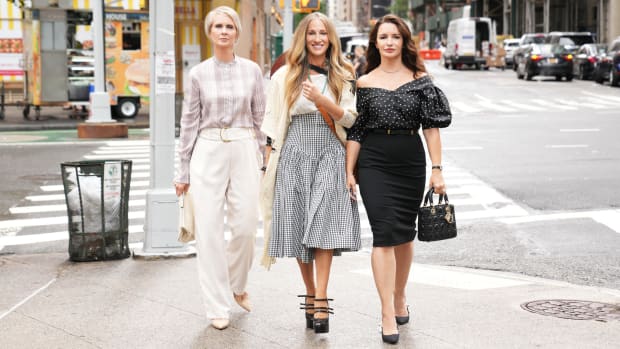How Jacqueline Durran Went From Selling Vintage Post-Grad to Winning an Oscar for Costume Design
In our long-running series "How I'm Making It," we talk to people making a living in the fashion and beauty industries about how they broke in and found success.
Chances are, the words "iconic movie gown" will immediately bring at least one of Jacqueline Durran's designs to mind — say, the '30s-ish, ethereal, yet devastatingly sultry green dress Keira Knightley wore as Cecilia Tallis in "Atonement" or the fairytale yellow ballgown Emma Watson waltzed around in as Belle life in the live-action "Beauty and the Beast." Both were dreamt up by Durran, and both earned her Oscar nominations.
In 2020, the designer is up to a whopping seven Academy Award noms, the latest thanks to her bohemian Victorian-era costumes (but with a modern touch) in "Little Women." Durran not only continues to awe audiences and critics alike with her stunning work on sweeping period epics, but also with gritty, powerful, even quotidian storytelling costumes — especially through regularly collaborating with two prestigious filmmakers over the course of her career.
Since her first official costume designer job on Mike Leigh's "All or Nothing," Durran has worked with the also-Oscar-nominated director, acclaimed for his exploration of slice-of-life contemporary British life, five more times: on "Vera Drake," "Happy-Go-Lucky," "Another Year," "Mr. Turner" and "Peterloo." Her first Academy Award nomination came in 2006, for the costumes in Joe Wright's "Pride & Prejudice." She's collaborated with the period auteur five times since, receiving her first Oscar win in 2013 for his "Anna Karenina" and nominations for the wardrobes in "Atonement" and "Darkest Hour."
While she graduated from the Royal College of Art, Durran didn't formally study costume or fashion design. Rather, she learned on the job, working from the ground up. She got her foot in the door via one of London's most famous costume rental houses, and subsequently secured a gig with veteran designer Lindy Hemming, assisting on big budget movies, including the 1999 James Bond installment "The World is Not Enough" and the Angelina Jolie-starring "Lara Croft: Tomb Raider" from 2001.
Related Articles:
Saoirse Ronan and Timothée Chalamet Swap Civil War-Era Costumes in 'Little Women'
How the 'Beauty and the Beast' Costume Designer Worked With Emma Watson to Bring a 'Modern, Emancipated' Belle to Life
The 'Wonder Woman' Costumes are a Celebration of Female Empowerment
Durran is currently filming a much-anticipated — but shrouded in mystery — project: "Felicity" co-creator and "Cloverfield" director Matt Reeves's noir retelling of Batman's origin story, starring giggler Robert Pattinson as Bruce Wayne. In a happy coincidence nearly two decades later, her mentor's upcoming project is "Wonder Woman 1984," also in the DCEU.
"I'm friends with Lindy and I keep meaning to call her and talk about the fact that we're doing it," says Durran, over the phone, during a break from filming "The Batman." She took the time to share with Fashionista how her love of vintage clothing helped start her Hollywood career, what she learned from Hemming and why costume designing "Little Women" and "The Batman" (or even Sam Mendes's "1917") are actually quite similar.
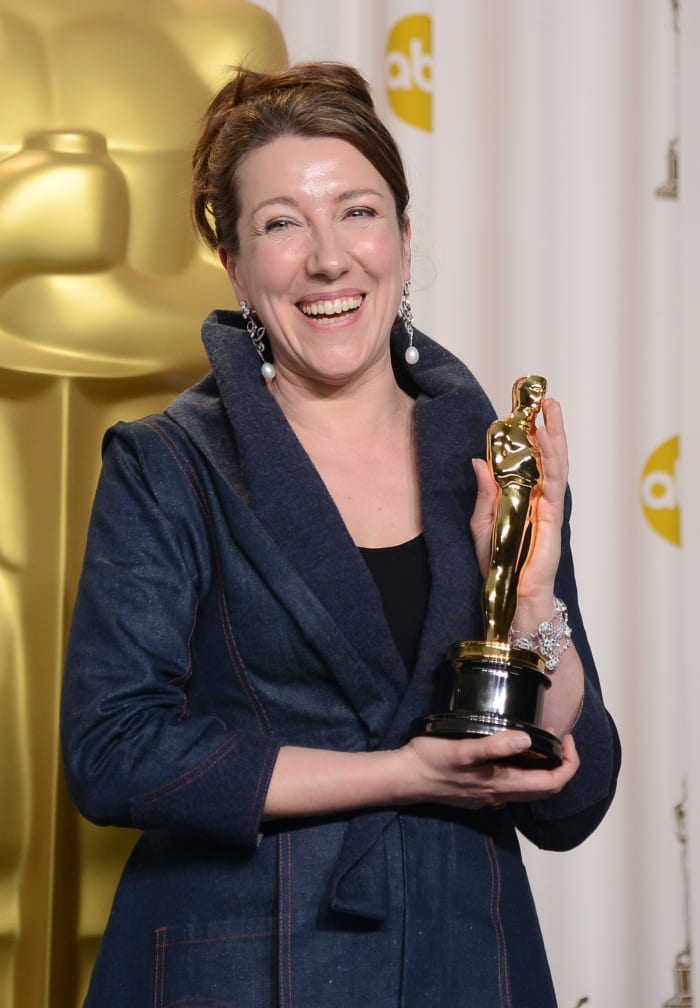
Durran after winning Best Costume Design for 'Anna Karenina' at the 2013 Academy Awards.
Photo: Jason Merritt/Getty Images
You began your career at a costume house in London and learned through that route. Take me back and tell me how you started your career.
Costume design was a job that I never knew existed when I was younger, all the way through college [and after graduation]. I didn't even know it was an option. I just realized by watching TV that somebody does the costumes — that it was a job — and that it was a possibility. I didn't know anyone in the industry or any way to get a job. Someone just randomly mentioned that there were costume rental houses and that I should contact one of those. So I did. The one that answered and interviewed me was called Angels.
I got the job because I was able to date clothes in the 20th century. When I left university, I had a market stall selling vintage clothes at Camden and Portobello Road markets. I was always very interested in buying vintage clothes and making clothes and thinking about style. But I was never thinking that it was going to be a career. I got the job at a junior level working at a costume house.
There's such an intricacy in your design and you custom-build so much. How did you learn that process?
The costume houses have changed now, but, in the early '90s, you used to do a lot of fittings. You'd work quite closely with costume designers on a general level and learn the nuts and bolts of how the costume process works. Working with lots of different designers, you got to see lots of different approaches, tastes and ways that people work.
I also met designers that I particularly got on with or admired. I then came to work more closely with them and would always do their jobs when they came to the costume house. One of those designers was Lindy Hemming, whom I ended up assisting for maybe five years after I left. I learned the nuts and bolts at the costume house, but then I learned in much more detail how to be a designer and how to work on a film [from her]. I also learned from other designers I worked with as an assistant, including Marit Allen ["Eyes Wide Shut"].
I worked with and learned a lot from Lindy Hemming. Then after I had been working with her for quite few years, she was approached by director Mike Leigh to do a film with him. She wasn't able to do it, so she said to me, 'I think you should do it.' I was really apprehensive about this and I didn't necessarily think I was going to be a designer. I was quite happy carrying on being an assistant, but she said, 'I think you should do it.' So she called Mike and asked if he would employ me to do the costumes and he said, 'Yes.' I had worked with her as her assistant on [the Leigh-directed] 'Topsy Turvy,' so I had experience working on his films and had that connection. That was my first design job. It was in 2001.
What did you learn from your assisting jobs — and from Lindy — that you still find valuable today?
How central it is to work with the actor in the creation of the character. I really followed her in that approach to costume and how central that relationship is. You're really working in a three-way situation. You're the costume designer. You're working with the actor and director and between the three of you is the place where you create the character. Because the character is something that the actor is developing but it's in the context of the movie that the director's making. So it's important that everything is in line.
There are many ways to be a costume designer. You can be a costume designer who designs the whole show before you ever meet an actor. But I much prefer to work things out with the actor and the director. That's the approach I got from her. It's also very influenced by the way Mike Leigh works, where the development of the character is the central thing.
You've collaborated frequently with Mike Leigh and Joe Wright. For you, what works in developing that trust and relationship to begin and maintain a regular gig with a director?
Recommended Articles
It is really nice. I don't think that you do anything different. I don't think there's a way in which you know you're going to work repeatedly with a director or not, apart from the fact you would get on with somebody. But you would always want to get on with someone you're working with anyway. I've just been really lucky that I happen to work with two people that like to have a loyal team and like to work with the same people. Some people like to change every time and find new inspirations. Because everybody approaches a creative project in a different way. But I've just been lucky in working with people like Mike. It's not really that usual, actually.
It's nice when a referral, like with Lindy, happens and then grows into an on-going collaboration.
It seemed like a natural thing and she was very kind, frankly.
The green dress you designed for Keira Knightley's character in Joe Wright's 'Atonement' is one of the most iconic and regularly referenced costumes. How has that dress influenced and affected your career?
I don't think it has actually any impact on my career, particularly. I don't know. But, the thing is, it was a kind of precious dress because, in the book, it had such an importance in the story. So it was always going to be something that had to have an equal importance in the arc of the film. It was very stressful trying to design a significant dress.
But I'll also say, it, again, comes back to the collaborative nature of film. Because, in the end, the dress's success was partly what it was — the color and the design and everything — but it was also partly Keira and partly the lighting that Seamus [McGarvey, cinematographer] did and it was partly the scene that Joe created and the sets that Katie Spencer made. So the whole picture becomes part of what everyone feels about the dress. So you have to think about that all the time in film. What you're creating is part of a combination of elements and they're put together by all the creative departments. You're successful when you're all together.
You've worked with Sally Potter ['Yes,' 2004], Susanna White ['Nanny McPhee Returns,' 2010] and, nearly 10 years later, Greta Gerwig. How does having a female director affect the dynamics of your job, especially on a project, like 'Little Women,' with a majority female cast?
Honestly, I don't notice so much a difference in the dynamic between working for a male or a female director. It doesn't have a huge impact on me in the sense that what you're trying to achieve for that person is the same thing. The way you throw yourself into your work — and what your creative aims are — are the same. So for me, there's not a huge difference in that, except I'm just very pleased and gratified that women are getting the chance to direct, but it doesn't necessarily change the relationship.
It was an unusual situation to work on a film with no male leads — or very few — and with the main parts being played by women. I just find it particularly thrilling and I was happy to be working with such talented young actresses and to see people of that generation just approaching the work seriously and intelligently and with so much talent that it was inspirational.
As an example, in 2017 you designed 'Beauty and the Beast' and 'Darkest Hour' and, last year, 'Little Women' and '1917.' What have been your biggest challenges and/or adventures costume designing such different projects and time periods in one year? How do you switch gears?
The way I choose [my projects] is just by director because the director is just the absolute key to any project. Because I always say, 'Anything can be interesting and anything can be boring.' It just depends on how you look at it and it's absolutely critical that you work with a director that you can be excited by their point of view and their take on something. Otherwise, you wouldn't choose it.
The period it's set in is not the most important thing. You just want to be able to get your teeth into something and take a new approach to something, like if you're doing the 1860s over again. Like 'Anna Karenina and 'Little Women,' by chance, are similar periods. 'Anna Karenina' is set in 1873, and 'Little Women' is 1863, but they're so different. The date doesn't mean anything. They're not the same product. There's such a difference between the two projects.
'The Batman' is your first foray into superhero costume design, which is its own beast — vocal superfans, comic book inspirations, concept artists and all that. What has been the learning curve or surprising aspects of this current project?
Because Batman is a man, it's not fully in the [superhero] universe. But it is a new adventure for me and it's very interesting because it's something I've not done before. The absolute thing about it, yet again, [is] the director. I'm trying to make the film that director Matt Reeves wants to make. The other things — the previous films, the comics and everything else — are relevant to a degree that they're relevant to a Matt Reeves movie. So, again, that's how important the director is, because you're concentrating on their vision.
'Little Women' is another example. How many times has the movie been made? [A lot.] But I'm only doing Greta Gerwig's version, so I only need to focus on the interpretation that Greta is looking for. It clears the decks a bit because what you're focused on that particular vision on this situation and that's what you're there to do.
You've costume designed so many different types of stories and time periods. Is there a genre that you haven't done yet, but you've been itching to do?
I would quite like to do something where you create different world. But not a world that is in space and is totally separate a variation on the ancient past or the far future. I'm quite interested in how you think about an evolution of today into something else — not like a 'traveling fast in spaceships' kind of world, but a world where you try and imagine how people could live in a different environment and how their clothes would be in response to that.
What advice would you give aspiring designers out there?
Above everything else, experience is the thing that you need and that's easier said than done, I know. Because it's difficult to get your foot in the door. It's very interesting to study costume and it is very interesting to learn dress history and learn as much as you can and and observe as much as you can — about costume and about fashion and about the way people wear things. But I think that the main thing is just doing the job. You shouldn't worry too much about where or what you study. If you've got the passion for it, you should, of course, study it, but try to find as much experience as you can.
This interview has been edited and condensed for clarity.
Never miss the latest fashion industry news. Sign up for the Fashionista daily newsletter.


